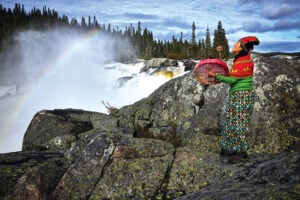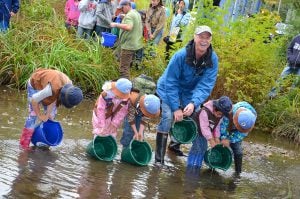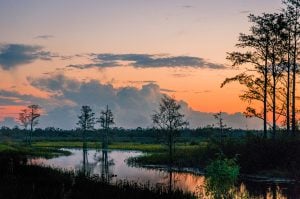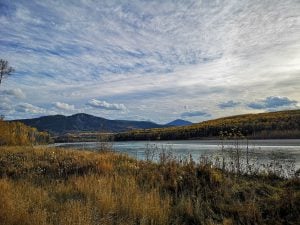Map: Chris Brackley/Canadian Geographic)
“Beavers can eviscerate a dog,” says Nicola Ross matter-of-factly as we paddle our kayaks up to an enormous dam that the sharp-toothed rodents have built at the edge of a glassy-smooth bay on Ontario’s French River. “They come up from underneath the water and … ” Her voice trails off. I grip my paddle a little tighter as the barrier of logs, brush and mud looms ahead. It’s about 15 to 20 metres long and at least three to four metres high — and that’s just what’s visible above the waterline. God knows what’s lurking below.
The fearsome creature of my imagination never chomps our boats, of course. In fact, the biggest danger we face during our two-hour return journey from the Lodge at Pine Cove — the gorgeous, 1930s-style resort on the shores of the French River that Ross’s partner Alex Strachan runs — is getting our feet wet as we step into and out of the kayaks.
But damp boots (and a short-term irrational fear of beavers) are a small price to pay for exploring the French River region, a glorious corridor of rock, river and forest between Lake Nipissing and Georgian Bay. It’s underrated territory, lost in the shadow of Ontario’s big outdoor draws, such as Algonquin Provincial Park, Temagami or the Kawartha Lakes. But make no mistake — this is as classically Canadian a destination as any of those.
Strachan himself knew he’d found something special when he first set eyes on the then-rundown lodge in 1995. By 1999, tired of his real estate career in Toronto, he’d bought the place. Shortly after he completed renovations — a library, a lounge and 17 simple yet elegant cottages — Strachan began offering activities such as canoeing, kayaking, hiking and fishing. “We wanted to get people out on the water and engaged in this landscape because it’s truly remarkable,” he says later that afternoon. Today I’ve only seen hints of what the river has to offer, but I find it hard to argue with him as I watch the sun set over a shimmering Wolseley Bay.
The next morning I get the bigger picture, courtesy of René Lahaie, who’s been running tours on the French River since 1999. With his weathered face, bushy grey eyebrows and long, candycoloured sash wrapped around his waist, he could pass for a modern-day voyageur. As his pontoon boat putters past low cliffs and the forest’s fiery autumnal blush, Lahaie explains how First Nations people and, subsequently, European explorers, fur traders and proselytizers used the river. “This was the highway to the West in the 1600s,” he says. “Everybody came through here — Champlain, Cadillac, Jean de Brébeuf, Radisson and Des Groseilliers.”
We hop ashore at the western end of Okikendawt Island to explore Five Finger Rapids, a boiling stretch of whitewater that crashes through narrow channels of Canadian Shield rock. As we walk, Lahaie points out various plants. The stuff that looks like camouflage netting growing on a huge slab of stone is rock tripe, a lichen with an earthy, mushroomy taste that First Nations people and coureurs de bois used as a thickener in soups and stews. The minty wintergreen we’re chewing on five minutes later is more appealing; it was used for everything from tea to a cure for indigestion.
I keep an eye out for both plants later that day while hiking through the woods surrounding the lodge, but to no avail. The forest floor’s slippery patchwork of brilliant oranges and reds is more alluring anyway, even with the steady drizzle that’s falling. As I clamber over a rocky outcrop, the flat, grey surface of a lake speckled with raindrops comes into view. The air is still. Nothing moves. It is perfect.
Over the past three days I’ve engaged with the landscape, as Strachan had suggested, and loved every minute of it. But this is the first time I’ve been out on it by myself, and suddenly it’s a tad overwhelming. Then I picture the voyageurs of 400 years ago, paddling the same waters, tramping the same ground and camping under the stars, and realize that I’m ridiculous. I turn, laugh into the silence and keep exploring.
French River timeline
Ontario’s French River has long served as a conduit for people and trade. In the roughly 2,800 years since its formation, everyone from First Nations groups and early European explorers to 19th-century lumberjacks and modern-day thrill-seekers have journeyed its waters, which connect Lake Nipissing and Georgian Bay. Here’s a brief timeline of some of the key events in the river’s rich history.
Circa 800 B.C. — The French River is formed.
1609 Samuel de Champlain secures an alliance with the Huron and Algonquin people, who bring furs down the French and Ottawa rivers to merchants in Quebec.
August 1610 Champlain sends a man — believed to be Étienne Brûlé — to live with the Algonquin in the interior. Brûlé probably accompanies them on their annual fall trip to Huronia, via the Mattawa and French rivers, becoming in all likelihood the first white man to canoe the French River.
June 1615 Father Joseph Le Caron journeys to Huronia (the area south and west of Georgian Bay), becoming the first documented white man to travel on the French River.
July 1615 Champlain journeys to Huronia on the French River.
1626 Jesuit priest Jean de Brébeuf visits Huronia via the French River, where he stays for three years.
1634 European explorers travelling on the French River introduce contagious diseases into the Great Lakes region. Over the next six years, the Huron population drops to less than half its original size.
1639 Jesuits establish Sainte-Marie Among the Hurons, a fortified mission near present-day Midland, Ont. People, animals, supplies, tools, weapons and more are all ferried to the mission via the French River.
1654 Médard Chouart Des Groseilliers travels on the French River during a successful two-year mission to expand the French fur trade’s frontier farther west, going as far as Wisconsin and the southwest shore of Lake Superior. He returns with 50 canoes laden with fur.
1659 Des Grosseilliers and his cousin Pierre-Esprit Radisson canoe the French River on another lucrative journey to Wisconsin and the shores of Lake Superior. They return a year later, this time with 60 fur-filled canoes.
1761 Alexander Henry leaves Montreal after Britain takes control of New France in 1760. He heads for the interior, becoming the first Englishman to canoe the French River.
Circa 1875 French River Village is established near the river’s western outlet. Lumbering begins.
Mid-1880s The first tourists start arriving, drawn by the excellent fishing
1908 Rail lines connecting Sudbury, Ont., and Toronto are completed. Tourism increases.
1912-1914 Large lumber companies begin leaving French River Village.
1934 French River Village becomes a ghost town.
1954 Completion of Highway 69 between Sudbury and Parry Sound, Ont., provides direct access to the French River.
1986 The French River is designated as the first Canadian Heritage River.
1989 A swath of the French River region is made into today’s 73,503-hectare French River Provincial Park.
Source: French River: Canoeing the River of the Stick-Wavers, by Toni Harting
The Lodge at Pine Cove
Accommodation
The 17 private cottages at The Lodge at Pine Cove have come a long way from the days of the run-down, shack-like shelters that anglers used when the property was nothing more than a cheap fishing camp.
Built between 2003 and 2013, each of the classically simple cedar-and-white-pine cottages (studio and one-, two- or three-bedroom) features a bathroom, living room and screened porch, where you can sit and take in views of the French River and surrounding forest. A coffee maker, a small fridge, handmade essential oil soaps and a hairdryer are just some of the small details that make a stay here more than just pleasant, not to mention the daily maid service. And, in a nod to the region’s history, most of the cottages are named after well-known figures that passed through the area, including Brebeuf, Brûlé, Radisson, Des Groseilliers, David Thompson and Paul Kane, among others.
Food and drink
Sure, the surrounding scenery and the chance to canoe or kayak the French River are big draws for The Lodge at Pine Cove, but don’t forget the food. There’s a lot of it here, and it is fabulous. From the breakfast hamper — think homemade granola, yogurt and freshly baked croissants that will put you into a pastry coma — to the excellent dinners and gourmet picnic lunches, the lodge is a foodie’s paradise. For lunches and dinners, expect to tuck into everything from artisanal cheeses and spiced couscous to fresh pickerel and steak. Wash it all down with wine or beer from the lodge’s bar. If you feel like staying put and your cottage is equipped with a barbecue, then order a barbecue hamper and grill to your heart’s content.






